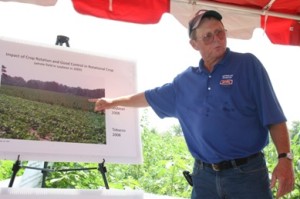Weed Scientists Urge More Vigilance Against Resistant Palmer

Weed scientists from Tennessee and North Carolina used the occasion of Monsanto’s 12th Annual Union City Field Day to issue another wake-up call to Mid-South growers on guarding against resistant weeds, especially Palmer amaranth and other pigweeds.
“No matter how much we see and talk about or what gets written about…seems like growers still only react when they get it on their own fields,” lamented Dr. Larry Steckel, weed scientist at the University of Tennessee. “This Palmer amaranth can grow so fast, that you must be proactive in your prevention.”
Steckel related his firsthand experience of seeing Palmer grow a foot in 13 days – from seven inches to nearly 20 – making it too big to control with anything but manual labor. To demonstrate, he showed the crowd a photo of a mound of pulled weeds on a trailer in a field.
“For that you might need a chainsaw,” one grower in the audience joked. It’s probably a telling sign that few other growers really laughed.
Weed scientist Dr. Alan York of North Carolina State University first shared good news, then a warning.
“Driving up here from Memphis, I can say that you certainly don’t have the kind of problem that we have,” he told the group, indicating that they have a chance to avoid a lot of misery if they apply themselves to the solution.
York posed the question, “What makes Palmer amaranth a super weed?” He then pointed to its speedy growth, heat and drought resistance, and prolific seed production as being key reasons.
“Research on soybean plants shows that they will just shut down and cease to grow when the temperature reaches 95 degrees,” explains York. “Palmer Amaranth loves warmer temperatures into the 100s.”
York says minimizing the seed bank is a crucial component of controlling this weed. Some keys to control include crop rotation, using alternating modes of action in crop protection and only planting cotton into clean fields.
“We’ve got to get back to using some of this other good chemistry that we’ve had good results with in the past,” he says. Other important components include using a strong pre-plant herbicide and /or a pre- program and overlapping residual herbicides, says York.









